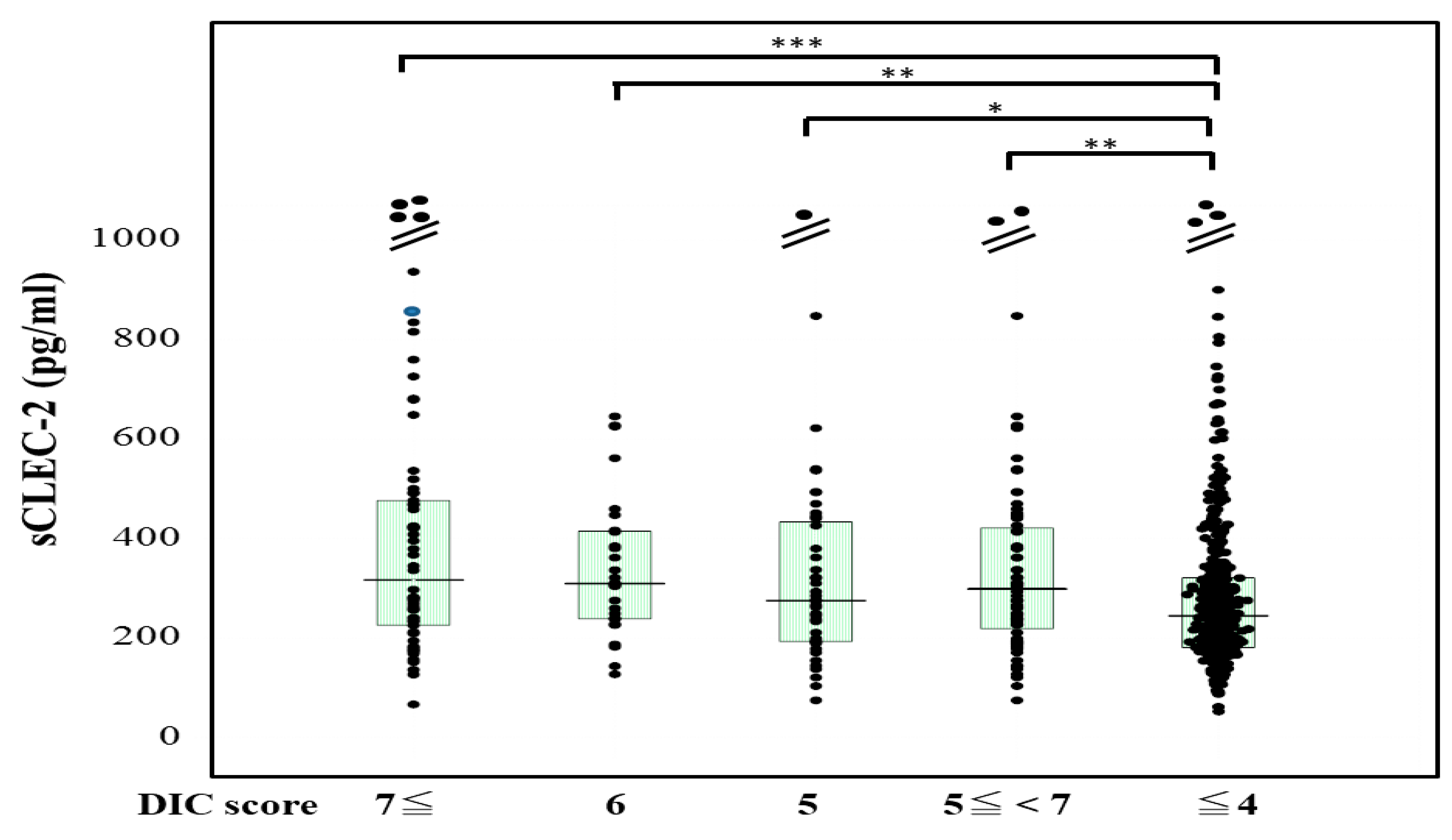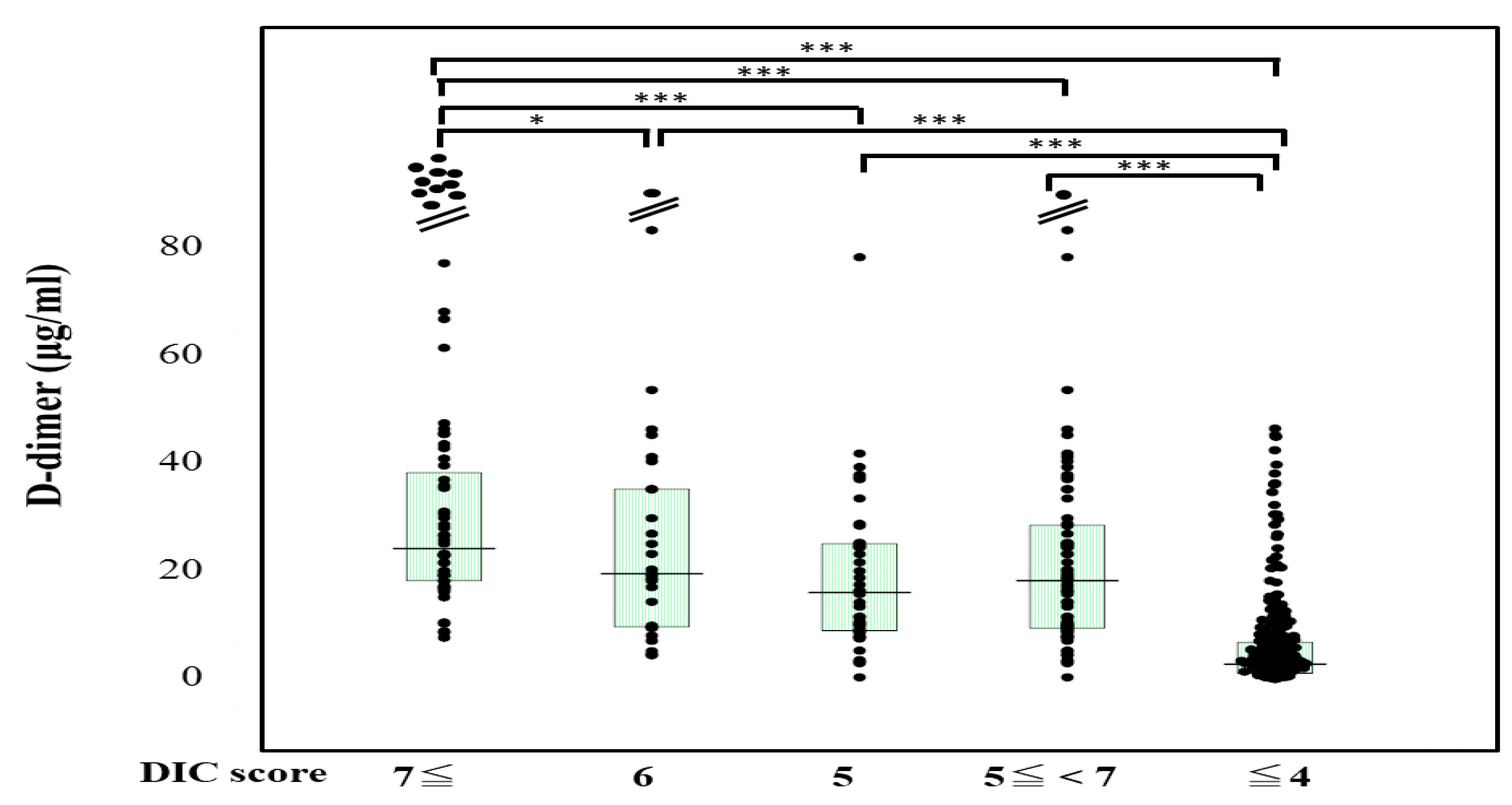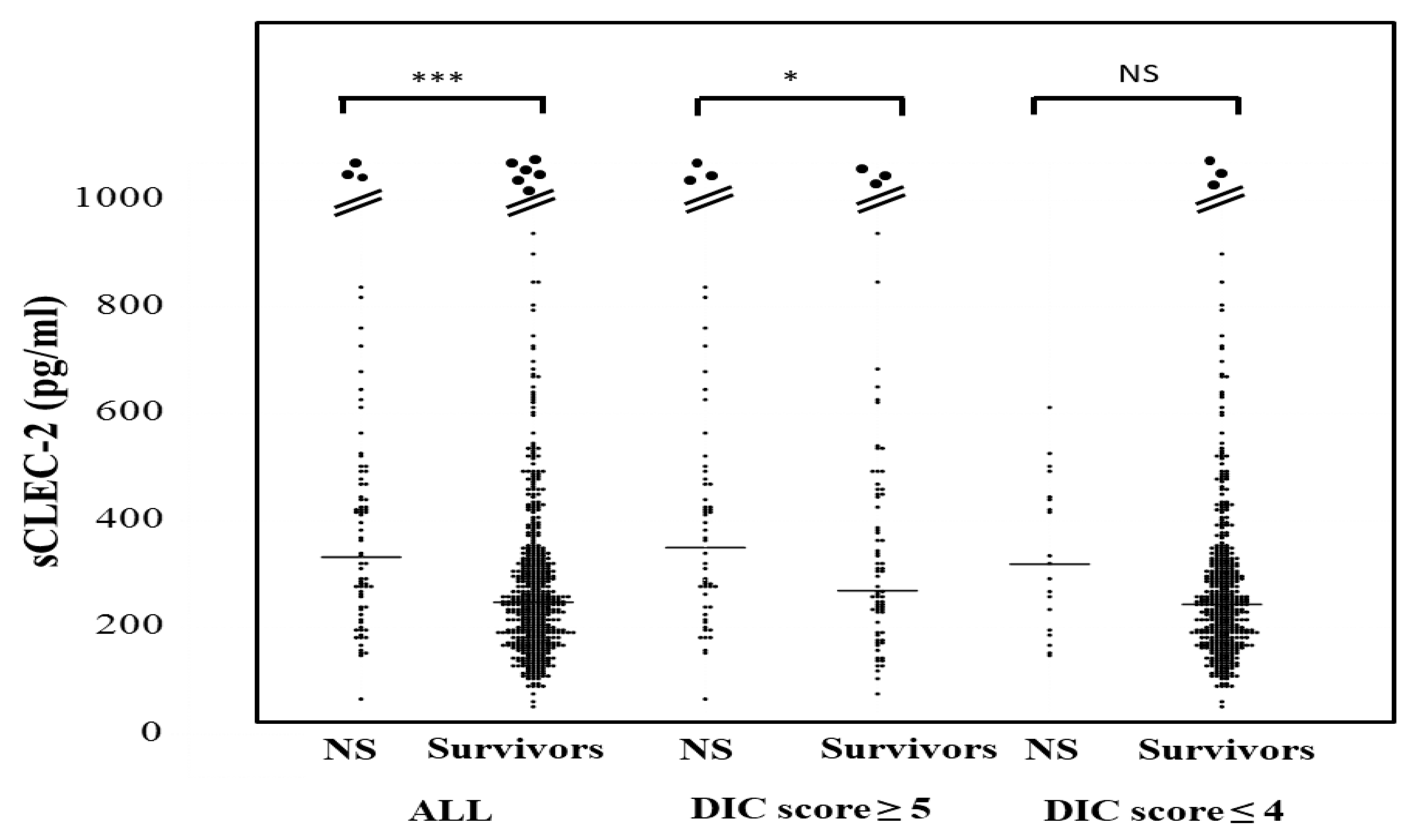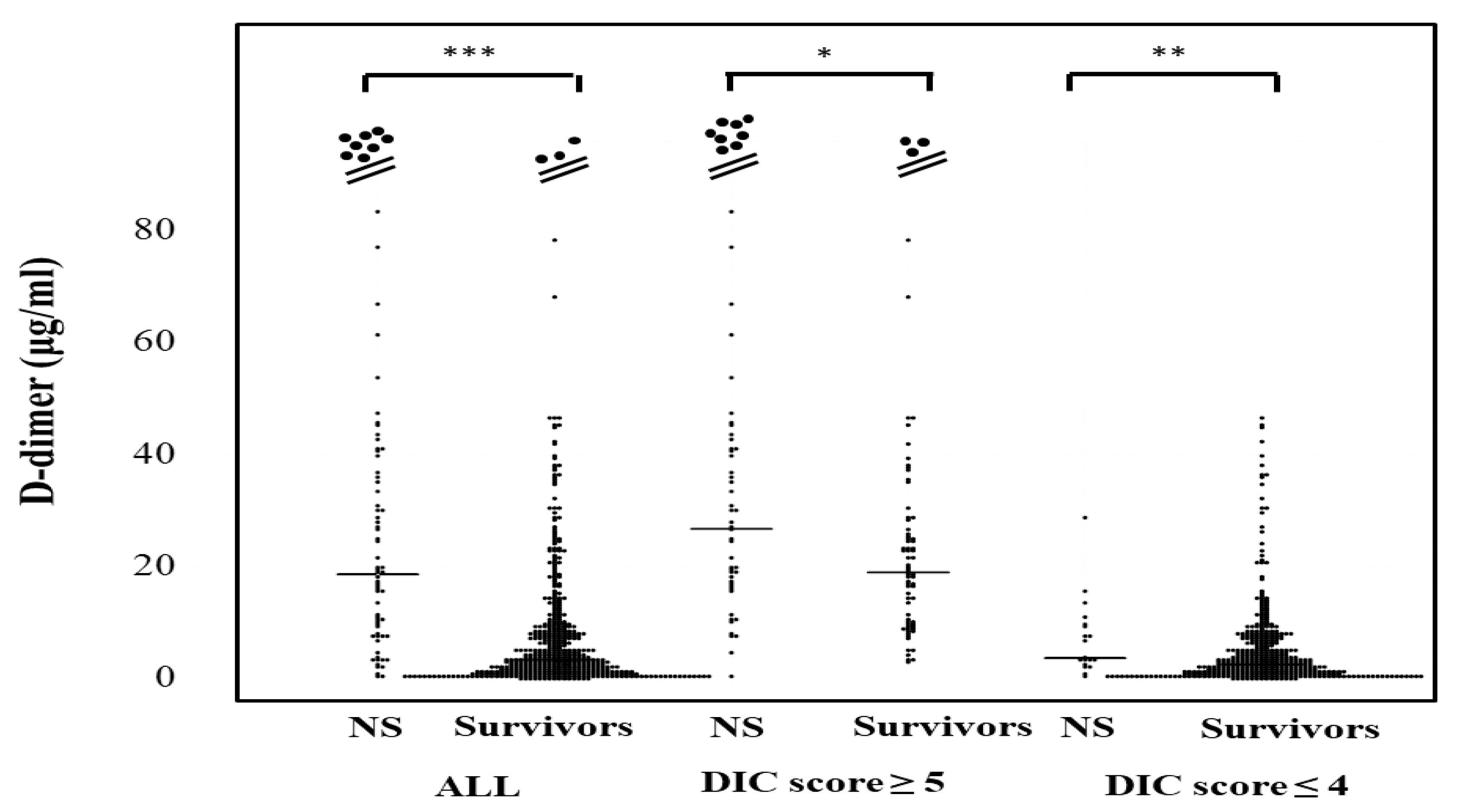Soluble C-Type Lectin-Like Receptor 2 Is a Biomarker for Disseminated Intravascular Coagulation
Abstract
:1. Introduction
2. Materials and Methods
2.1. Measurement of sCLEC-2 and D-Dimer Levels
2.2. Statistical Analysises
3. Results
4. Discussion
5. Conclusions
Author Contributions
Funding
Institutional Review Board Statement
Informed Consent Statement
Data Availability Statement
Acknowledgments
Conflicts of Interest
References
- Wada, H.; Thachil, J.; Di Nisio, M.; Mathew, P.; Kurosawa, S.; Gando, S.; Kim, H.K.; Nielsen, J.D.; Dempfle, C.E.; Levi, M.; et al. The Scientific Standardization Committee on DIC of the International Society on Thrombosis Haemostasis.: Guidance for diagnosis and treatment of DIC from harmonization of the recommendations from three guidelines. J. Thromb. Haemost. 2013, 11, 761–767. [Google Scholar] [CrossRef]
- Levi, M. Disseminated Intravascular Coagulation in Cancer: An Update. Semin. Thromb. Hemost. 2019, 45, 342–347. [Google Scholar] [CrossRef]
- Iba, T.; Levi, M.; Levy, J.H. Sepsis-Induced Coagulopathy and Disseminated Intravascular Coagulation. Semin. Thromb. Hemost. 2020, 46, 089–095. [Google Scholar]
- Wada, H.; Honda, G.; Kawano, N.; Uchiyama, T.; Kawasugi, K.; Madoiwa, S.; Takezako, N.; Suzuki, K.; Seki, Y.; Ikezoe, T.; et al. Severe Antithrombin Deficiency May be Associated with a High Risk of Pathological Progression of DIC With Suppressed Fibrinolysis. Clin. Appl. Thromb. Hemost. 2020, 26. [Google Scholar] [CrossRef] [PubMed]
- Taylor, F.B., Jr.; Toh, C.H.; Hoots, K.; Wada, H.; Levi, M. Towards a definition, clinical and laboratory criteria, and a scoring system for disseminated intravascular coagulation. Thromb. Haemost. 2001, 86, 1327–1330. [Google Scholar] [CrossRef] [PubMed] [Green Version]
- Ichkawa, Y.; Wada, H.; Ezaki, M.; Tanaka, M.; Hiromori, S.; Shiraki, K.; Moritani, I.; Yamamoto, A.; Tashiro, H.; Shimpo, H.; et al. Elevated D-Dimer Levels Predict a Poor Outcome in Critically Ill Patients. Clin. Appl. Thromb. Hemost. 2020, 26. [Google Scholar] [CrossRef]
- Iba, T.; Levy, J.H.; Raj, A.; Theodore, E. Warkentin: Advance in the Management of Sepsis-Induced Coag-ulopathy and Disseminated Intravascular Coagulation. J. Clin. Med. 2019, 8, 728. [Google Scholar] [CrossRef] [Green Version]
- Wada, H.; Shiraki, K.; Shimaoka, M. Errors in the diagnosis for DIC due to a statistical misunderstanding. J. Thromb. Haemost. 2020, 18, 1791–1792. [Google Scholar] [CrossRef]
- Matsumoto, T.; Yamashita, Y.; Wada, H. Natural History of Thrombotic Thrombocytopenic Purpura and Hemolytic Uremic Syndrome. Semin. Thromb. Hemost. 2014, 40, 866–873. [Google Scholar] [CrossRef] [PubMed]
- Wada, H.; Matsumoto, T.; Suzuki, K.; Imai, H.; Katayama, N.; Iba, T.; Matsumoto, M. Differences and similarities between disseminated intravascular coagulation and thrombotic microangiopathy. Thromb. J. 2018, 16, 14. [Google Scholar] [CrossRef]
- Yamashita, Y.; Naitoh, K.; Wada, H.; Ikejiri, M.; Mastumoto, T.; Ohishi, K.; Hosaka, Y.; Nishikawa, M.; Katayama, N. Elevated plasma levels of soluble platelet glycoprotein VI (GPVI) in patients with thrombotic microangiopathy. Thromb. Res. 2014, 133, 440–444. [Google Scholar] [CrossRef]
- Aota, T.; Naitoh, K.; Wada, H.; Yamashita, Y.; Miyamoto, N.; Hasegawa, M.; Wakabayashi, H.; Yoshida, K.; Asanuma, K.; Matsumoto, T.; et al. Elevated soluble platelet glycoprotein VI is a useful marker for DVT in postoperative patients treated with edoxaban. Int. J. Hematol. 2014, 100, 450–456. [Google Scholar] [CrossRef]
- Suzuki-Inoue, K.; Fuller, G.L.; Garcia, A.; Eble, J.A.; Pohlmann, S.; Inoue, O.; Gartner, T.K.; Hughan, S.C.; Pearce, A.C.; Laing, G.D.; et al. A novel Syk-dependent mechanism of platelet activation by the C-type lectin receptor sCLEC-2. Blood 2006, 107, 542–549. [Google Scholar] [CrossRef] [PubMed] [Green Version]
- Yamashita, Y.; Suzuki, K.; Mastumoto, T.; Ikejiri, M.; Ohishi, K.; Katayama, N.; Suzuki-Inoue, K.; Wada, H. Elevated plasma levels of soluble C-type lectin-like receptor 2 (sCLEC-2) in patients with thrombotic microangiopathy. Thromb. Res. 2019, 178, 54–58. [Google Scholar] [CrossRef] [PubMed]
- Al-Tamimi, M.; Grigoriadis, G.; Tran, H.; Paul, E.; Servadei, P.; Berndt, M.C.; Gardiner, E.E.; Andrews, R.K. Coagulation-induced shed-ding of platelet glycoprotein VI mediated by factor Xa. Blood 2011, 117, 3912–3920. [Google Scholar] [CrossRef] [PubMed] [Green Version]
- Inoue, O.; Osada, M.; Nakamura, J.; Kazama, F.; Shirai, T.; Tsukiji, N.; Sasaki, T.; Yokomichi, H.; Dohi, T.; Kaneko, M.; et al. Soluble CLEC-2 is generated in-dependently of ADAM10 and is increased in plasma in acute coronary syndrome: Comparison with soluble GPVI. Int. J. Hematol. 2019, 110, 285–294. [Google Scholar] [CrossRef]
- Fei, M.; Xiang, L.; Chai, X.; Jin, J.; You, T.; Zhao, Y.; Ruan, C.; Hao, Y.; Zhu, L. Plasma soluble C-type lectin-like receptor-2 is associated with the risk of coronary artery disease. Front. Med. 2020, 14, 81–90. [Google Scholar] [CrossRef]
- Kobayashi, N.; Maekawa, T.; Takada, M.; Tanaka, H.; Gonmori, H. Criteria for Diagnosis of DIC Based on the Analysis of Clinical and Laboratory Findings in 345 DIC Patients Collected by the Research Committee on DIC in Japan. Bibl. Haematol. 1983, 49, 265–275. [Google Scholar]
- Hasegawa, M.; Wada, H.; Yamaguchi, T.; Wakabayashi, H.; Fujimoto, N.; Matsumoto, T.; Hasegawa, K.; Yamada, N.; Ito, M.; Yamashita, Y.; et al. The Evaluation of D-Dimer Levels for the Comparison of Fibrinogen and Fibrin Units Using Different D-Dimer Kits to Diagnose VTE. Clin. Appl. Thromb. Hemost. 2017, 24, 655–662. [Google Scholar] [CrossRef]
- Wada, H.; Matsumoto, T.; Yamashita, Y.; Hatada, T. Disseminated intravascular coagulation: Testing and diagnosis. Clin. Chim. Acta 2014, 436, 130–134. [Google Scholar] [CrossRef]
- Kipshidze, N.; Dangas, G.; White, C.J.; Kipshidze, N.; Siddiqui, F.; Lattimer, C.R.; Carter, C.A.; Fareed, J. Viral Coagulopathy in Patients With COVID-19: Treatment and Care. Clin. Appl. Thromb. Hemost. 2020, 26, 1076029620936776. [Google Scholar] [CrossRef] [PubMed]




| Disease | Age (Years) | Sex (F:M) | PT–INR | PLT (109/L) | sCLEC–2 (pg/mL) | D–Dimer (μg/mL) | CRP (mg/dl) | DIC Score ≥ 5 | Mortality |
|---|---|---|---|---|---|---|---|---|---|
| Infection | 76.5 | 109:137 | 1.13 *** | 2.07 ** | 379 *** | 4.7 *** | 9.2 *** | 60 | 25 |
| (57.0–83.0) | (1.03–1.25) | (1.33–2.64) | (275–798) | (1.8–11.1) | (3.0–16.5) | (24.4%) | (10.2%) | ||
| Aortic aneurysm | 72.0 | 30:45 | 1.06 *** | 1.82 *** | 307 *** | 7.4 *** | 1.9 *** | 9 | 3 |
| (50.0–78.0) | (0.99–1.18) | (1.42–2.17) | (246–489) | (3.2–13.2) | (0.2–7.3) | (12.0%) | (4.0%) | ||
| Trauma# | 69.0 | 32:30 | 1.02 ** | 2.18 | 247 *** | 6.2 *** | 0.6 *** | 13 | 5 |
| (45.0–80.0) | (0.93–1.08) | (14.1–27.2) | (177–353) | (2.5–22.2) | (0.1–3.0) | (21.0%) | (8.1%) | ||
| CPA | 79.5 | 9:23 | 1.48 *** | 1.16 ** | 652 *** | 23.6 *** | 0.6 *** | 25 | 29 |
| (66.0–86.5) | (1.13–1.94) | (0.71–2.26) | (440–1162) | (9.0–44.7) | (0.2–4.8) | (78.1%) | (90.6%) | ||
| Solid cancer | 72.5 | 14:18 | 1.06 *** | 2.43 | 279 *** | 4.1 *** | 2.9 *** | 7 | 8 |
| (67.5–79.5) | (0.99–1.18) | (1.70–3.14) | (194–365) | (2.5–15.1) | (0.7–9.9) | (21.9%) | (25.0%) | ||
| Obstetric disease | 30.0 | 37:0 | 0.98 | 2.32 | 207 | 2.5 *** | 0.2 | 3 | 0 |
| (30.0–42.0) | (0.94–1.04) | (1.63–2.52) | (153–276) | (1.7–7.8) | (0.1–0.3) | (8.1%) | (0%) | ||
| Other DIC/ Pre–DIC | 78.0 | 4:7 | 1.51 *** | 1.32 *** | 424 *** | 21.6 *** | 9.4 *** | 11 | 4 |
| (66.3–84.3) | (1.31–1.70) | (0.72–1.32) | (257–464) | (19.2–39.2) | (4.0–27.2) | (100%) | (36.4%) | ||
| UCS | 61.0 | 43:37 | 0.96 | 2.34 | 194 | 0.7 | 0.1 | 0 | 0 |
| (48.0–73.5) | (0.92–1.00) | (1.87–2.75) | (146–250) | (0.4–1.6) | (0.0–0.3) | (0%) | (0%) |
Publisher’s Note: MDPI stays neutral with regard to jurisdictional claims in published maps and institutional affiliations. |
© 2021 by the authors. Licensee MDPI, Basel, Switzerland. This article is an open access article distributed under the terms and conditions of the Creative Commons Attribution (CC BY) license (https://creativecommons.org/licenses/by/4.0/).
Share and Cite
Yamamoto, A.; Wada, H.; Ichkawa, Y.; Tanaka, M.; Tashiro, H.; Shiraki, K.; Shimpo, H.; Yamashita, Y.; Mastumoto, T.; Shimaoka, M.; et al. Soluble C-Type Lectin-Like Receptor 2 Is a Biomarker for Disseminated Intravascular Coagulation. J. Clin. Med. 2021, 10, 2860. https://doi.org/10.3390/jcm10132860
Yamamoto A, Wada H, Ichkawa Y, Tanaka M, Tashiro H, Shiraki K, Shimpo H, Yamashita Y, Mastumoto T, Shimaoka M, et al. Soluble C-Type Lectin-Like Receptor 2 Is a Biomarker for Disseminated Intravascular Coagulation. Journal of Clinical Medicine. 2021; 10(13):2860. https://doi.org/10.3390/jcm10132860
Chicago/Turabian StyleYamamoto, Akitaka, Hideo Wada, Yuhuko Ichkawa, Motoko Tanaka, Haruhiko Tashiro, Katsuya Shiraki, Hideto Shimpo, Yoshiki Yamashita, Takeshi Mastumoto, Motomu Shimaoka, and et al. 2021. "Soluble C-Type Lectin-Like Receptor 2 Is a Biomarker for Disseminated Intravascular Coagulation" Journal of Clinical Medicine 10, no. 13: 2860. https://doi.org/10.3390/jcm10132860
APA StyleYamamoto, A., Wada, H., Ichkawa, Y., Tanaka, M., Tashiro, H., Shiraki, K., Shimpo, H., Yamashita, Y., Mastumoto, T., Shimaoka, M., Iba, T., & Suzuki-Inoue, K. (2021). Soluble C-Type Lectin-Like Receptor 2 Is a Biomarker for Disseminated Intravascular Coagulation. Journal of Clinical Medicine, 10(13), 2860. https://doi.org/10.3390/jcm10132860







